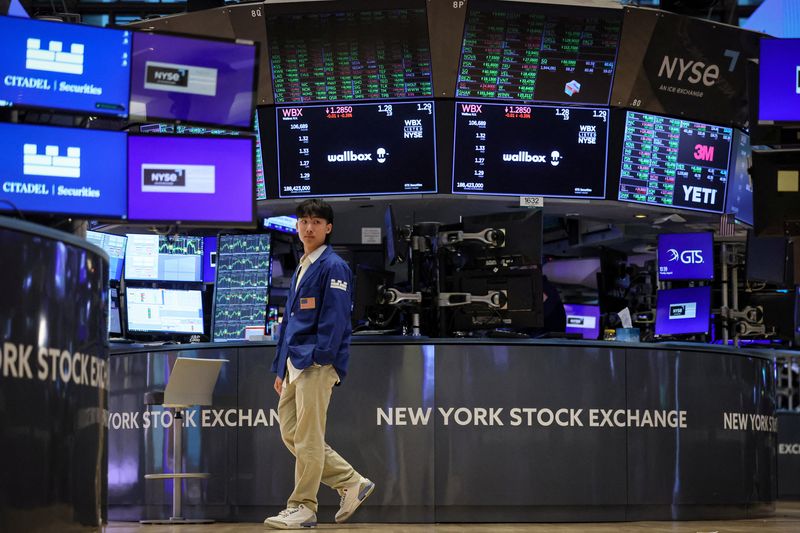Analysis-Bond markets face a reckoning after stellar summer run
By Yoruk Bahceli
(Reuters) - Government bond markets, which have enjoyed a summer of solid price gains, now face a reckoning with their bets for speedy central bank rate cuts and slowing inflation, not to mention a tight U.S. presidential election.
Benchmark 10-year U.S. Treasury yields are set to end August down nearly 30 bps, their biggest monthly drop this year, driven by expectations for speedier rate cuts - even as economic data has eased the recessionary fears sparked by the last U.S. jobs report.
With borrowing costs in Germany and Britain posting big drops in July, all three regions were already set for their first quarterly drops since the end of 2023. Bond yields move inversely with prices.
For some, these moves confirm one of the current big investment themes -- the notion that "bonds are back" after taking a beating amid the post-pandemic surge in inflation and interest rates.
Government bonds returned just 4% globally last year after 15% losses across 2021-22, and have returned 1.3% year-to-date.
Yet big investors reckon that gains will at best lose steam, or, at worst, prove to be overdone.
"We have many indicators showing that the economy is not falling into a recession. We are just in a soft landing," said Guillaume Rigeade, co-head of fixed income at Carmignac.
"It's not justified to us, this acceleration to a cutting cycle so quick," said Rigeade, who is bearish on longer-dated bonds on both sides of the Atlantic.
Bonds have been boosted by bets that the Federal Reserve will cut rates around 100 basis points across its three remaining meetings this year -- meaning one 50 bps move -- double the level expected in late July. Traders have also ramped up bets on peers like the European Central Bank.
The message appears at odds with equity markets, however, whose roundtrip has left returns flat since mid-July, while global government bonds have returned around 2%.
Economists polled by Reuters also expect roughly one move fewer than traders anticipate from the ECB and the Fed this year.
The discrepancies highlight the challenge of navigating the government bond market for the rest of 2024 for investors keen to earn meaningful returns.
TESTING TIMES
The first test takes shape in the form of next week's August U.S. jobs report.
If that shows a second month of significant weakness, it may increase bets on a 50 bps Fed move in September, while a stronger print may price out cuts, analysts said.
"We're in the slowing point of the economic cycle... It's where you get the most volatility in terms of data like payrolls," said Guy Stear, head of developed markets strategy at Amundi Investment Institute, the research arm of Europe's largest asset manager.
He recommends assessing how much of their summer falls bond yields maintain in early September before adjusting positioning.
Bond markets have also been supported by easing inflation. Market gauges of inflation expectations recently fell to their lowest level in more than three years in the U.S. and their lowest in nearly two years in the euro zone.
While headline figures are nearing central bank targets, core inflation remains stickier on both sides of the Atlantic, warranting caution.
"The market is too optimistic in the way it is pricing a perfect normalisation," Carmignac's Rigeade said, adding that risks were skewed towards inflation coming in higher than expected in the coming quarters.
While contained, the surge in oil prices driven by tensions in Libya and the Middle East in recent sessions is a sign of uncertainty ahead.
NOVEMBER PUZZLE
No doubt, the elephant in the room remains November's U.S. presidential election.
The race between Vice President Kamala Harris and Republican rival Donald Trump is tight, and 61% of investors in BofA's August survey were still not trading the election in U.S. Treasuries.
"Whatever the outcome will be, it will result in still high fiscal spending and large bond supply of U.S. Treasuries," said Capital Group investment director Flavio Carpenzano.
A Trump presidency backed by a Republican Congress would pressure longer-dated bonds in particular, implying both higher spending and inflation that risks remaining above the Fed's 2% target, Carpenzano added.
A focus on fiscal discipline, along with more clarity on U.S. growth, may support euro zone bonds, which outperformed last year but have underperformed U.S. peers this year.
The U.S. economy grew faster than expected in the second quarter and economists polled by Reuters have upgraded their expectations for growth over the year as a whole to 2.5%.
They still forecast 0.7% growth this year in the euro zone, which saw economic growth of just 0.3% last quarter while Germany unexpectedly contracted.
"If there's one economy which needs proper (interest rate cuts), it's the euro zone, because that's where the fundamentals are weaker and deteriorating," said Salman Ahmed, Fidelity International's global head of macro and strategic asset allocation.
Source: Investing.com
